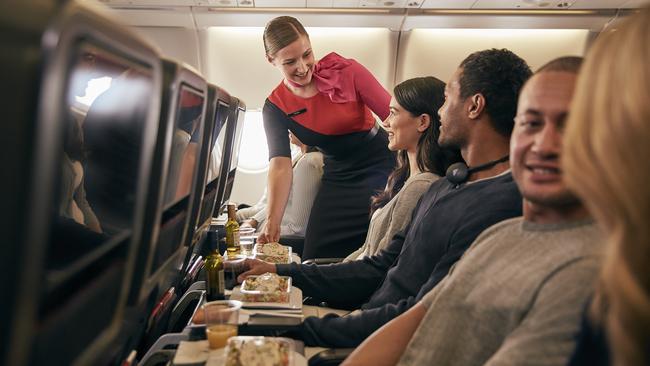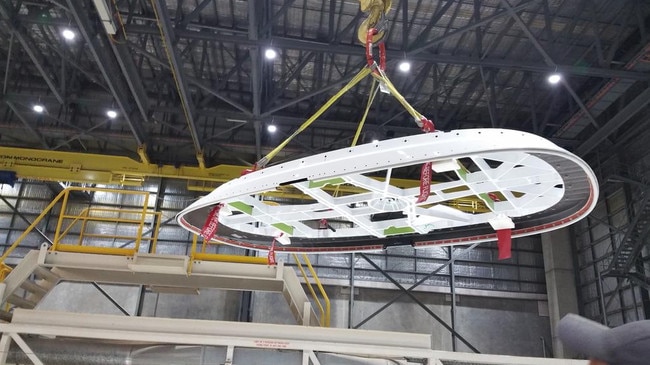Qantas boots up wi-fi on international routes, flights to Singapore and Hong Kong first in line
Qantas has quietly switched on wi-fi on select international routes after delays placed it behind rival carriers that have offered internet connectivity in the skies for years.

Business
Don't miss out on the headlines from Business. Followed categories will be added to My News.
Qantas has quietly switched on wi-fi on select international routes after delays placed it behind rival carriers that have offered internet connectivity in the skies for years.
Qantas expected to launch its free international wi-fi service at the end of last year but it is understood a technical issue with provider Viasat delayed the rollout by more than three months.
It is currently only available on select routes in Asia on Qantas’s A330-200 aircraft to destinations including Hong Kong and Singapore. The airline expects to expand the service to trans-Tasman flights in the middle of the year before launching it on other international routes, including to Europe.
The race to offer more internet access in the skies – what has been considered the last bastion of disconnectedness – has intensified. Other airlines are already offering internet speeds in flight capable of supporting video calls and streaming services, at no extra cost to passengers.
Qatar has partnered with Elon Musk’s Starlink to offer passengers “internet connection from gate to gate at no cost”. Emirates offers free wi-fi to some of its Skywards members, depending on their class of travel, while United offers connectivity for a fee, which can be paid in cash and points.

Qantas fellow Oneworld alliance member Cathay Pacific launched a new subsidiary, Cathay Technologies, this month to deliver “innovative digital solutions to the aviation industry”, including wi-fi.
The Hong Kong-based airline said from August it would offer “100 per cent high-speed in-flight connectivity across its fleet, setting a new standard for premium air travel” at various prices.
Cathay Pacific general manager for customer experience design Guillaume Vivet said: “We understand the importance our customers place on having access to top-notch entertainment and reliable connectivity when they travel.
“Whether for business or leisure, our customers will soon have access to both award-winning entertainment and unparalleled connectivity on board all our flights, making their journeys as memorable as their destinations.”
But wi-fi can be patchy when travelling over parts of the Indian and Pacific oceans, which is part of the reason Qantas has waited so long to launch the technology.

Qantas executive manager for product and service, Phil Capps, last year said the airline didn’t want to offer a service that failed to meet customers’ expectations and matches the free service that has long been available on domestic flights.
Mr Capps said California-based Viasat’s $US7.3bn merger with British satellite company Inmarsat in 2023 meant Qantas could offer uninterrupted broadband on its selected routes – even eventually on those to South Africa that fly south towards Antarctica, where internet is typically unavailable. The merger doubled the number of satellites, allowing greater redundancy and coverage across the globe.
“We’ve set a really strong benchmark with our domestic wi-fi offering. We didn’t want to go out strong with international wi-fi until we were comfortable that we could meet a comparable benchmark,” Mr Capps said.
“Now, various circumstances have put us in a position where we’re comfortable with that.”
Another reason for the delay is the task of retrofitting aircraft, with A380 planes more challenging than newer Boeing 787 Dreamliners – the design of which was overseen by Australian David Carbon, who has since left Boeing to head Amazon Prime Air.

“When we acquired the A380s, it was before 2010, the available on-air infrastructure was quite limited, so the work that’s involved in us now taking an A380 and fitting it with the latest gen wi-fi is considerably bigger,” Mr Capps said.
“You have to essentially put a hole in the roof of the aircraft to install the radome and antenna to create that wi-fi environment. There was some provisioning on the A380, but it was limited. In contrast, on the 787s, because that’s a much later acquisition of the fleet, we provision the aircraft hull itself with enough infrastructure so at a later time when we wanted to put wi-fi in, we were somewhat complete.”
While Qantas has lagged rivals, including Qatar, Emirates and United, other airlines continue to keep the skies a no internet zone. South Korean low-cost carrier T’way Air has no wi-fi or in-flight entertainment, leaving passengers to pass the time the old-fashioned way on 10-hour services from Seoul to Sydney.
More Coverage
Originally published as Qantas boots up wi-fi on international routes, flights to Singapore and Hong Kong first in line





